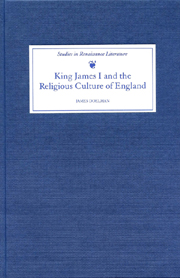Book contents
- Frontmatter
- Preface
- Chapter 1 BEGINNINGS: THE ROOTS OF JAMES' ROLE IN RELIGIOUS CULTURE
- Chapter 2 THE ACCESSION OF KING JAMES I AND ENGLISH RELIGIOUS POETRY
- Chapter 3 PROPHETS AND THE KING
- Chapter 4 KING JAMES, ANDREW MELVILLE AND THE NEO-LATIN RELIGIOUS EPIGRAM
- Chapter 5 FROM CONSTANTINIAN EMPEROR TO REX PACIFICUS: THE EVOLVING ICONOGRAPHY OF JAMES I
- Chapter 6 KING JAMES AND THE POLITICS OF CONVERSION
- Chapter 7 THE SONGS OF DAVID: KING JAMES AND THE PSALTER
- Chapter 8 THE DEATH OF SOLOMON
- WORKS CITED
- Index
Chapter 8 - THE DEATH OF SOLOMON
Published online by Cambridge University Press: 05 February 2013
- Frontmatter
- Preface
- Chapter 1 BEGINNINGS: THE ROOTS OF JAMES' ROLE IN RELIGIOUS CULTURE
- Chapter 2 THE ACCESSION OF KING JAMES I AND ENGLISH RELIGIOUS POETRY
- Chapter 3 PROPHETS AND THE KING
- Chapter 4 KING JAMES, ANDREW MELVILLE AND THE NEO-LATIN RELIGIOUS EPIGRAM
- Chapter 5 FROM CONSTANTINIAN EMPEROR TO REX PACIFICUS: THE EVOLVING ICONOGRAPHY OF JAMES I
- Chapter 6 KING JAMES AND THE POLITICS OF CONVERSION
- Chapter 7 THE SONGS OF DAVID: KING JAMES AND THE PSALTER
- Chapter 8 THE DEATH OF SOLOMON
- WORKS CITED
- Index
Summary
“His rest, no question, is in Abraham's bosom, and his crown changed into a crown of glory.”
AT the beginning of King James' reign, William Thorne had reminded him that while men might praise him as a God, he would “die like a man”, an eminently safe, if unwelcome, prediction. Daniel Price, dean of Hereford, in his sermon preached at Theobalds just hours before James' death, recalled that biblical verse as well. The occasion of the king's death, in March 1625, provided the people of England with an opportunity to reconsider both the human and divine qualities of their monarch of twenty-two years. Some attention was also given to the mark he had left on religious life in England, but this aspect of his life received far less attention than at his accession. As at earlier times, biblical comparisons were common, with the peaceful King Solomon most often presented as the type of James. The most important of these works marking James' death was the funeral sermon preached by John Williams, bishop of Lincoln, entitled “The Death of Solomon”. More so than most poems and speeches it surveyed James' life and reign, rather than looking forward to the possibilities his death opened up. Williams' sermon was a sort of lone light, in striking contrast to the general speed with which the late English king's life and death were forgotten, as attention turned to the immediate situation of a royal marriage and foreign conflicts.
- Type
- Chapter
- Information
- King James I and the Religious Culture of England , pp. 158 - 166Publisher: Boydell & BrewerPrint publication year: 2000



